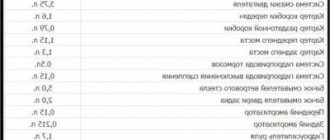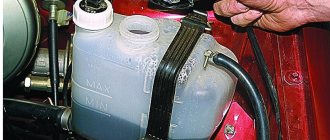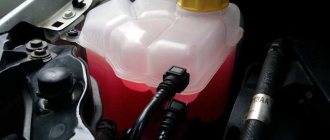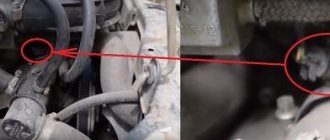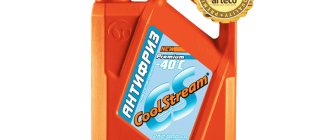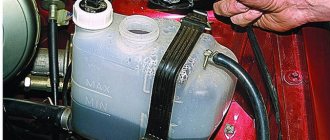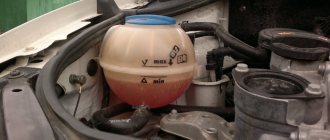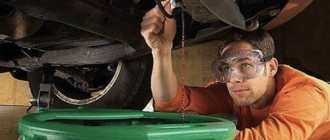Stages of replacing Chevrolet Niva coolant
When switching from antifreeze to antifreeze, it is necessary to flush the cooling system. This is done so that the new liquid does not lose its properties when mixed. Also, due to the different chemical composition, a precipitate or flakes may form. Therefore, the correct procedure between draining and filling should include a flushing step.
This model is quite popular, so many people know it under other names:
- Chevrolet Niva;
- Chevy Niva;
- Shniva;
- VAZ-21236.
We will consider the instructions for replacing the coolant using the example of a 1.7-liter gasoline engine. But there is one nuance: cars after the 2016 restyling have electronic control of the gas pedal.
Accordingly, there are no pipes for heating the throttle valve. Therefore, we will consider bleeding air on this modification. You can also familiarize yourself with the nuances of replacement on a regular Niva 4x4, the replacement on which we also described.
Coolant drain
To drain the antifreeze, you need to place the car on a flat surface, open the cap of the expansion tank and wait a little until the temperature drops below 60°C. For further convenience, remove the decorative plastic protection on top of the engine.
Further in the instructions we are recommended to turn the temperature regulator to maximum. But it is useless to do this. Since the temperature control in the Chevrolet Niva occurs by moving the air damper. And not by blocking the radiator as in old VAZs.
After the machine has cooled down a little, we begin the draining process itself:
- If you stand in front of the car, at the bottom right, there is a plastic valve on the radiator that closes the drain hole. We unscrew it to drain the antifreeze from the radiator (Fig. 1). When unscrewing, be careful not to lose the rubber O-ring.
In this way, we completely drained the old fluid, but in any case, a small part still remains in the system, distributed among the engine channels. Therefore, in order for the replacement to be high-quality, we proceed to flushing the system.
Flushing the cooling system
If the Chevrolet Niva cooling system is not clogged, but is simply undergoing a scheduled replacement, then we use ordinary distilled water for flushing. To do this, close the drain holes and pour distilled water into the expansion tank.
Then close the tank cap and start the engine. We warm it up until the thermostat opens to flush both circuits. Next, turn it off, wait for it to cool and drain the water. To achieve a good result, it is recommended to do this procedure 2-3 times.
If the car system is heavily contaminated, it is recommended to wash it with special chemical solutions. For these purposes, washes from well-known brands, such as LAVR or Hi Gear, are suitable. Recommendations, as well as instructions, are usually printed on the back of the container with the composition.
Filling without air pockets
To properly fill new antifreeze into a Chevrolet Niva, you need to perform a number of steps. After all, it depends on whether an air lock forms in the system or not. We will close the drain holes in stages, so for now we will leave them open:
- We begin to pour antifreeze into the expansion tank, as soon as it flows through the drain hole in the radiator, we put the wing plug in place.
- We continue the flood until it starts flowing from the hole in the block. After which we close it too. The drain bolt on the block must be clamped with a slight force, approximately 25-30 N•m, if you have a torque wrench.
- Now we need to bleed the air from the top of the radiator. To do this, we find a special plug, the location of which is shown in the photo (Fig. 3). We unscrew it a little, continue to pour antifreeze into the tank, as soon as it flows, screw the cap back into place.
The system is completely filled with new antifreeze, now all that remains is to start the engine, wait until it warms up completely, and check the level. Some people advise starting the car with the reservoir open and closing it after 5 minutes to get rid of air pockets as much as possible. But when replacing according to these instructions, they should not be there.
Lubrication system
The Chevy Niva lubrication system itself is also combined. The oil pump supplies oil under pressure to the bearings, crankshaft, and drive helical gear. Some parts are lubricated by splashing. Characteristics of containers requiring lubrication:
- engine lubrication capacity is 3.75 l;
- It is better to use synthetic and semi-synthetic SUPER oil. Its viscosity class: from -25 to +30, +35 - 5W30, 5W40; from -15-+45 — 15W 40; from -10-+45 — 20W 40;
- Transmission oils from Lukoil TM-4 are made on a mineral (80W 85, 80W-90) and semi-synthetic base (75W-90) and are off-season, high-quality, as they use additives from the world's best manufacturers. They are needed for gearbox housings (1.6 l);
- the same oil is used for the transfer case (0.79 l);
- for the front (1.15 l) and rear (1.3 l) axles use 80W 90 and 85W 90;
- the power steering needs 1.7 liters of Pentosin Hydraulic Fluid CHF115;
- The hydraulic front shock absorber (0.15 l) and rear shock absorber (0.215) are filled with Slavol-AZh or GRZh-12 operating fluid.
Replacement frequency, what antifreeze to fill
In the maintenance information for Niva Chevrolet, it is recommended to change antifreeze every 60,000 kilometers. But many car enthusiasts are not happy with the flooded antifreeze, which becomes unusable by 20 thousand. Dzerzhinsky antifreeze is usually filled from the factory, but there is also information about pouring red antifreeze.
When choosing coolant, it is better to use a concentrate rather than a finished product. Since it can be diluted in the required proportion, because after flushing there is still some distilled water left in the system.
A good choice would be Castrol Radicool SF concentrate; it is what dealers often recommend for use. If you choose ready-made antifreezes, then you should pay attention to the red AGA Z40. FELIX Carbox G12+ or Lukoil G12 Red with good reviews.
Fuel tank characteristics
The fuel tank of this model has almost sixty liters, or more precisely 58. On average, per hundred kilometers you have to spend 8-9 liters of AI-95, Premium-95 or AI-92 gasoline. Features of the fuel container:
- the tank is located directly under the rear seat;
- in the upper part there is a small hatch under which the fuel pump is installed;
- The sensor will help determine the level of fuel fluid and the amount of gasoline.
There are other Chevrolet Niva filling tanks , many of which are included in various systems.
This is interesting: What is the volume of oil in a T 40 engine
Leaks and problems
When replacing the coolant, you should inspect all pipes and connections for possible problems. After all, when the fluid is drained, it is easier to replace them than to tear them during operation. You need to pay special attention to the clamps; for some reason, many people use ordinary worm clamps. Over time, they squeeze the hoses, causing them to break.
In general, the Chevrolet Niva has several main problems related to the cooling system. It often happens that antifreeze leaves the expansion tank. The plastic on it constantly bursts, which causes leaks. In this case, replacement will be required.
Another problem is antifreeze under the driver's mat, which can cause a sweetish smell in the cabin and also fog up the windows. Most likely the culprit will be a leaking heater radiator. This problem is usually referred to as “a chef’s nightmare.”
There is also a situation where antifreeze is thrown out of the expansion tank. This may indicate a broken cylinder head gasket. This is checked as follows. With the car completely cooled down, remove the expansion tank cap, after which you need to start the engine and rev it up intensively. It is advisable to have a second person so that he can see whether the antifreeze in the tank will bubble at this time.
Video
- Ratchet wrench
- Extension
- 8 mm head
- 10 mm head
- 13 mm head
- Narrow nose pliers
- Torque wrench
- Knife
- Funnel
Parts and consumables:
- Coolant 8 l (10 l with reserve)
- Technical capacity
- Radiator Cap O-ring (if required)
- Plastic bottle
- Rags
According to the Chevrolet Niva maintenance regulations, the coolant should be replaced after two years of operation or after 60 thousand kilometers, whichever comes first. In addition, if the coolant changes color to a reddish color, replace it immediately, as such a change indicates that inhibitory additives have developed and the liquid has become aggressive towards the parts of the cooling system.
Replace coolant only when the engine is cold.
1. Place the car on a ditch and open the hood.
2. Remove the oil sump guard and engine splash guard as described.
The crankcase protection and mudguard may not be removed, but in this case you will have to use some kind of device to collect the drained liquid, otherwise it will inevitably spill across the area under the car.
3. Relieve excess pressure in the cooling system by unscrewing the expansion tank cap.
4. Place a wide container with a volume of at least 8.5 liters under the drain hole made in the lower part of the left radiator tank. To reduce the intensity of liquid drainage at the initial moment, the cap of the expansion tank should be tightly screwed on.
5. Unscrew the radiator drain plug by hand and drain the coolant from the radiator into a substitute container.
Coolant is toxic and lethal to all living things, so be careful when working with it. To avoid polluting the environment, drain the radiator through a funnel (such as one made from a plastic soda bottle).
The drain plug is sealed with a rubber ring. Replace a ring that is torn, cracked or has lost elasticity.
6. Unscrew the cap of the expansion tank.
7. To drain the coolant from the engine cooling jacket, place a container under the drain hole located on the left side of the cylinder block next to the ignition module, and unscrew the drain plug using a 13 mm socket with an extension.
8. The connection between the plug and the cylinder block uses a conical thread that does not require additional sealing. Close the radiator and cylinder block drain plugs. Tighten the drain plug of the cylinder block to a torque of 25-30 N∙m.
9. Before filling the cooling system with liquid, remove the engine screen (if any), use narrow-nose pliers to loosen the clamp securing the coolant supply hose to the throttle assembly and remove the hose from the pipe.
10. Pour liquid into the engine cooling system through the expansion tank until liquid flows from the coolant supply hose to the throttle body. After this, install the hose in place and secure it with a clamp.
Use coolants recommended by the manufacturer.
11. Close the cap of the expansion tank.
Screw the expansion tank cap tightly. The expansion tank is under pressure when the engine is running, and therefore, if the plug is loosely tightened, coolant may leak from under it.
12. Start the engine. When the engine warms up, the radiator outlet (lower) hose should be cold for some time, and then quickly heat up, which will indicate the beginning of fluid circulation in a large circle. After waiting for the cooling fan to turn on, stop the engine.
When starting the engine, the expansion tank cap must be closed.
With the engine running, monitor the coolant temperature according to the gauge. If the arrow reaches the red zone and the fan does not turn on, turn on the heater and check what kind of air flows through it. If the heater supplies heated air, it means that the fan is most likely faulty, and if it is cold, it means that an air lock has formed in the engine cooling system. But there shouldn’t be a plug, since the cooling system was depressurized before adding liquid (see point 9).
13. After the engine has cooled, check the coolant level in the tank and bring it to normal (it should be between the MIN and MAX marks).
Lubrication system
The Chevy Niva lubrication system itself is also combined. The oil pump supplies oil under pressure to the bearings, crankshaft, and drive helical gear. Some parts are lubricated by splashing. Characteristics of containers requiring lubrication:
- engine lubrication capacity is 3.75 l;
- It is better to use synthetic and semi-synthetic SUPER oil. Its viscosity class: from -25 to +30, +35 - 5W30, 5W40; from -15-+45 — 15W 40; from -10-+45 — 20W 40;
- Transmission oils from Lukoil TM-4 are made on a mineral (80W 85, 80W-90) and semi-synthetic base (75W-90) and are off-season, high-quality, as they use additives from the world's best manufacturers. They are needed for gearbox housings (1.6 l);
- the same oil is used for the transfer case (0.79 l);
- for the front (1.15 l) and rear (1.3 l) axles use 80W 90 and 85W 90;
- the power steering needs 1.7 liters of Pentosin Hydraulic Fluid CHF115;
- The hydraulic front shock absorber (0.15 l) and rear shock absorber (0.215) are filled with Slavol-AZh or GRZh-12 operating fluid.
High temperatures, constant loads and friction affect the service life and operating time of the motor. Without lubrication, gears and parts wear out quickly. In addition to cooling, it is possible to eliminate carbon deposits and microparticles.
Important ! The condition of the systems and the oil level should be monitored. A warning light helps with this, which will indicate a drop in pressure and is connected to the lubrication system. It is still better to entrust the replacement to specialists. It is better to use the oil that was poured into the engine. When changing the brand of oil, you need to drain the old one before the engine cools down.
How to choose coolant?
The selection of coolant should be approached responsibly.
Making a choice right away is not so easy. Today, stores offer a large selection of canisters and bottles of various colors and compositions. The question is brewing: what to fill - antifreeze or antifreeze? What does the manufacturer recommend?
Types and properties of coolants for cars
The best option for effectively lowering the temperature is antifreeze. This is a liquid that contains:
- distilled water;
- ethylene glycol or propylene glycol (less aggressive substance);
- additional additives.
Distilled water. Ethylene glycol based antifreeze.
Additives, in turn, are divided into the following subtypes:
- silicate;
- based on organic acids (carboxylate);
- hybrid antifreezes (based on the two described above).
Carboxylate coolants have good heat transfer and high cooling temperatures. They reliably fight fat deposits and have a longer service life. Silicate antifreezes perfectly prevent corrosion and reduce the temperature of aqueous solutions. They are considered universal.
Carboxylate coolant after 60,000 km
Depending on the additives used, a high-quality coolant must have a high boiling point and thermal conductivity. Also not to be exposed to freezing in the winter season, maintaining its performance. Do not form scale or foam.
Replacing antifreeze on a Niva Chevrolet
Replacing antifreeze on a Niva Chevrolet car must be carried out taking into account the strict frequency established by the manufacturer - once every 40,000 km, or (if the car owner rarely uses the car) every two years. At the same time, it is necessary to check the antifreeze level and replace it if it darkens or appears brown. Also, replacement of antifreeze may be necessary if the composition does not meet the required density or repair of the engine (cooling system elements) is required.
Which antifreeze is better, and how much to fill in a Chevrolet Niva?
To fill the cooling system you need 10 liters of high quality antifreeze (antifreeze). When choosing a suitable composition, you should focus on the recommendations of the manufacturer and the experience of servicing Niva Chevrolet vehicles. Let's look at the best options:
- Cars manufactured in 2002 are suitable for red antifreeze class G12. It is advisable to give preference to G-Energy or MOTUL Ultra.
- For cars manufactured from 2003 to 2009, the best choice is red antifreeze class G12+. Options - Lukoil Ultra, G-Energy, MOTUL Ultra, Havoline, Frostschutzmittel A.
- In Chevrolet Nivas produced since 2010, it is better to use red coolant G12++, namely products from the brands FEBI, Freecor QR, Frostschutzmittel A, VAG.
Replacement process
To replace antifreeze on a Niva Chevrolet, find an inspection hole. You can also work on an overpass or lift. It is important that the car stands strictly horizontally, with mandatory fixation, in order to avoid movement during the work process. If you can't find a perfectly level area, find an area where the front of the machine is slightly higher.
Before draining the antifreeze, perform a few more manipulations - wait until the engine cools down, remove the negative voltage from the battery, and also prepare the tool for work. You will need a ten-socket wrench, a funnel for filling coolant, pliers, a screwdriver, a new portion of antifreeze and a container for draining the coolant. Use a canister, bucket, basin or bottle as a drainage container.
Antifreeze Frostschutzmittel A from Febi
Let's start with how to drain antifreeze. Take a series of steps:
- Open and secure the hood.
- Unscrew the cap on the expansion tank. As noted above, wait until the engine cools down to avoid burning your hands. As a last resort, the coolant temperature should not exceed 90 degrees Celsius. Carefully unscrew the cap, take your time. Allow hot air to escape, which helps reduce pressure. After this, unscrew the cap completely.
- Unscrew the plug from the drain hole, and then wait until all the coolant comes out. Don't forget to place the container first to avoid getting antifreeze on the ground.
- As soon as the waste fluid leaves the system, screw the plug back into place.
To avoid air locks in the system, discard the tube from the fitting of the throttle assembly. To do this, take a screwdriver or pliers, and then, using the tool, loosen the fastener, and then move it back. Now remove the tube from the throttle body fitting.
Filling with new antifreeze
Above we looked at the first stage - how to drain antifreeze. The next step is to fill the system with new coolant. Remember that the composition must be prepared, because many antifreezes are sold as a concentrate and require dilution with distilled water, in a ratio of 1 to 1. Read the instructions carefully, because they may contain other information.
Next, do the following:
- Pour new antifreeze into the reservoir.
- Monitor the working fluid level. As soon as it comes out of the throttle assembly, return the hose to its place and install the clamp.
- Fill the cooling system. The antifreeze level should reach the MAX line.
- During the filling process, press the radiator tubes several times to prevent plugs from forming.
- After filling the cooling system, screw the cap on the expansion tank.
Chevrolet Niva
If the engine is hot, you need to let it cool and then relieve excess pressure in the cooling system by unscrewing the expansion tank cap. If the engine is hot, you need to let it cool and then relieve excess pressure in the cooling system by unscrewing the expansion tank cap.
We place a wide container with a volume of at least 8.5 liters under the drain hole made in the lower part of the left radiator tank. To reduce the intensity of liquid drainage at the initial moment, the cap of the expansion tank should be tightly screwed on.
We unscrew the radiator drain plug by hand and drain the coolant from the radiator into a substitute container. We unscrew the radiator drain plug by hand and drain the coolant from the radiator into a substitute container.
The drain plug is sealed with a rubber ring. Replace a torn, cracked or lost elasticity ring.
Unscrew the expansion tank cap.
To drain the coolant from the engine cooling jacket, place a container under the drain hole located on the left side of the cylinder block next to the ignition module.
Using a 13mm socket with an extension, unscrew the drain plug of the cylinder block and drain the liquid from the engine. Using a 13mm socket with an extension, unscrew the drain plug of the cylinder block and drain the liquid from the engine.
The connection between the plug and the cylinder block uses a conical thread that does not require additional sealing. We tighten the drain plugs of the radiator and cylinder block. We tighten the drain plug of the cylinder block with a torque of 25–30 N∙m.
Before filling the cooling system with liquid, remove the engine screen and use pliers to loosen the clamp securing the coolant supply hose to the throttle assembly... Before filling the cooling system with liquid, remove the engine screen and use pliers to loosen the clamp securing the coolant supply hose to the throttle assembly... >Chevrolet Niva
...and remove the hose from the pipe. ...and remove the hose from the pipe.
We pour liquid into the engine cooling system through the expansion tank until liquid flows from the coolant supply hose to the throttle body. We pour liquid into the engine cooling system through the expansion tank until liquid flows from the coolant supply hose to the throttle body.
After this, install the hose in place and secure it with a clamp. We wrap the cap of the expansion tank. Let's start the engine. When the engine warms up, the radiator outlet (lower) hose should be cold for some time, and then quickly heat up, which will indicate the beginning of fluid circulation in a large circle. After waiting for the cooling system fan to turn on, stop the engine.
After the engine has cooled, check the coolant level in the tank and bring it to normal (it should be between the MIN and MAX marks). After the engine has cooled, check the coolant level in the tank and bring it to normal (it should be between the MIN and MAX marks).
According to the maintenance regulations for a Chevrolet Niva, the coolant should be replaced every 60 thousand kilometers.
Chevrolet > Niva
Motor oils
| Oil brand | SAE viscosity grade | Group | Manufacturer | Regulatory document | |
| AAI | AP1 | ||||
| LUKOIL LUX | 5W-30, 5W-40 10W-40,15W-40 | B5/D3 | SJ/CF | STO 00044434-003 | |
| LUKOIL LUX | 0W-40, 5W-20, 5W-30, 5W-50, 10W-30 | B5/D3 | SL/CF | LLC "Lukoil-Permnefteorg-sintez", Perm | STO 00044434-003 |
| TNK SUPER | 5W-30, 5W-40 10W-40 | B5/D3 | SJ/SL/CF | TU 0253-008-44918199 | |
| TNK MAGNUM | 5W-30, 5W-40 10W-40,15W-40 | B5/D3 | SJ/SL/CF | TU 0253-025-44918199 | |
| ROSNEFT MAXIMUM | 5W-40, 10W-40 | B5/D3 | SL/CF | TU 0253-063-48120848 | |
| ROSNEFT OPTIMUM | 10W-30, 10W-40 15W-40 | B5/D3 | SJ/CF | OJSC "Novokuibyshevsk Oil and Additives Plant", Novokuibyshevsk | TU 0253-062-48120848 |
| ROSNEFT MAXIMUM | 5W-40, 10W-40 | B5/D3 | SL/CF | TU 0253-391-05742746 | |
| ROSNEFT OPTIMUM | 10W-30, 10W-40 15W-40 | B5/D3 | SJ/CF | OJSC "Angarsk Petrochemical Company", Angarsk | TU 0253-389-05742746 |
| ROSNEFT PREMIUM | 0W-40, 5W-40 5W-40 | B5/D3 | SJ/CF SL/CF SM/CF | OJSC "Angarsk Petrochemical Company", Angarsk | TU 0253-390-05742746 |
Continuation of the table. 2
| Oil brand | SAE viscosity grade | Group | Manufacturer | Regulatory document | |
| AAI | API | ||||
| EXTRA 1 EXTRA 5 EXTRA 7 | 5W-30 15W-40 20W-50 | B5/D3 | SJ/CF | OJSC "Omsk Oil Refinery", Omsk | TU 38.301-19-137 |
| EXTRA | 5W-30, 10W-40, 15W-40 | B5/D3 | SL/CF | OJSC "Omsk Oil Refinery", Omsk | TU 38.301-19-137 |
| ESSO ULTRA | 10W-40 | B5/D3 | SJ/SL/CF | Exxon-Mobil, Germany | |
| GTTURBO SM | 10W-40 | B5 | S.M. | Hanval INC, Korea | |
| LIQUI MOLY OPTIMAL | 10W-40 | B5/D3 | SL/CF | Liqui Moly GmbH, Germany | |
| MOBIL 1 MOBIL SYNT S MOBIL SUPER S | 0W-40, 5W-50 5W-40 10W-40 | B5/D3 | SJ/SL SM/CF SJ/SL/CF | Exxon-Mobil, Germany | |
| MOBIL 1 ESP FORMULA | 5W-30 | B6/D3 | SJ/SL SM/CF | ||
| RAVENOL HPS RAVENOL VSI RAVENOL LLO RAVENOL TSI RAVENOL Turbo-C HD-C | 5W-30 5W-40 10W-40 10W-40 15W-40 | B5/D3 | SL/CF SL/CF SL/CF SL/CF SJ/CF | Ravensberger Schmirstoffvertrieb GmbH, Germany | |
| SHELL HELIX: PLUS PLUS EXTRA ULTRA | 10W-40 5W-40 5W-40 | B5/D3 | SL/CF | SHELL EAST EUROPE Co, UK, Finland | |
| ZIC A PLUS | 5W-30, 10W-30, 10W-40 | B5 | SL | SK CORPORATION, Korea | |
Table 3
| Minimum engine cold start temperature, 0C | Viscosity grade according to SAE J 300 | Maximum ambient temperature, 0C |
| below -35 | 0W-30 | 25 |
| below -35 | 0W-40 | 30 |
| -30 | 5W-30 | 25 |
| -30 | 5W-40 | 35 |
| -25 | 10W-30 | 25 |
| -25 | 10W-40 | 35 |
| -20 | 15W-40 | 45 |
| -15 | 20W-40 | 45 |
